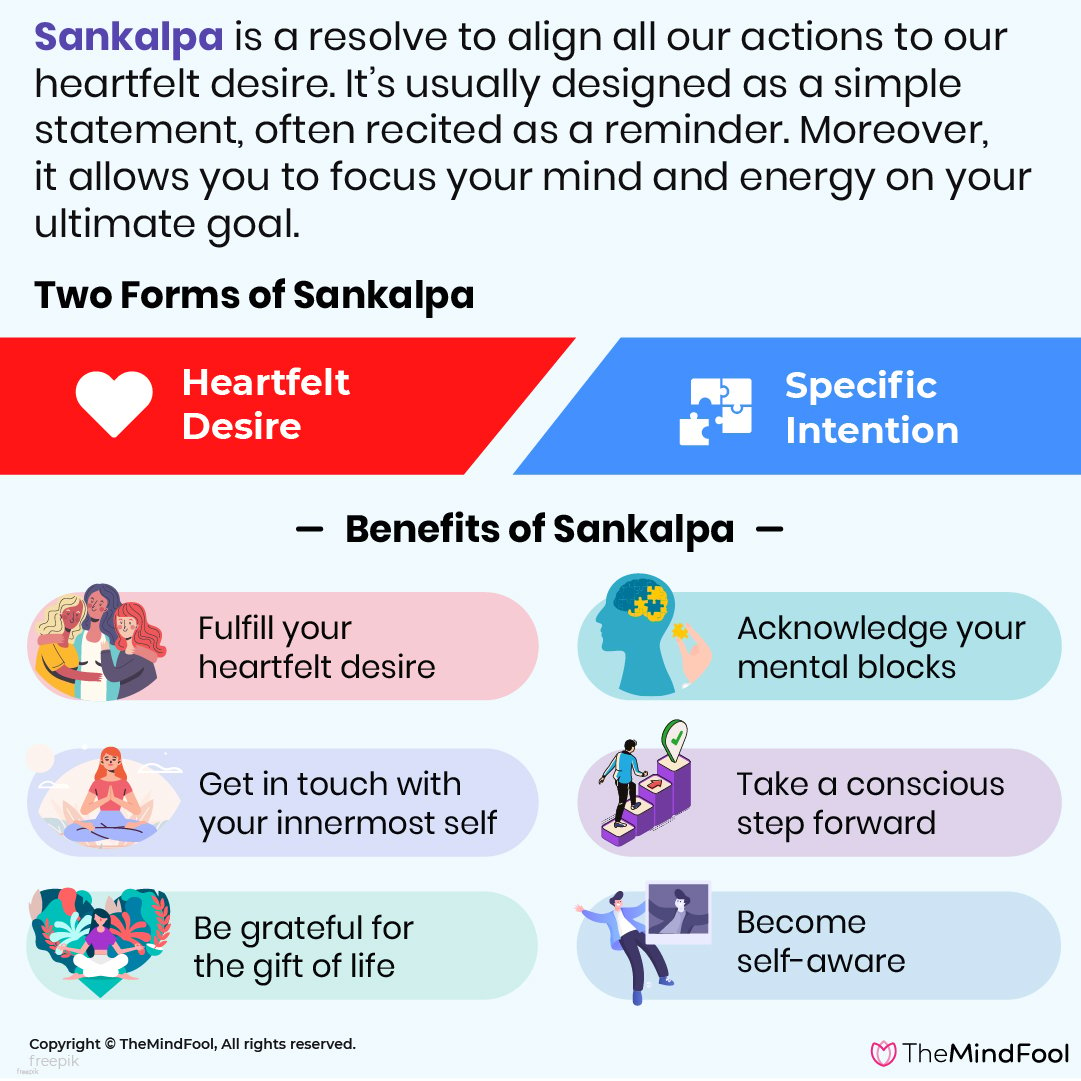
As humans, our lives are a series of actions in some sense. You conduct some of them with consciousness and the others happen unconsciously. When your unconscious choices dominate your actions, life does not always go the way we want it to. To have more control over our lives, we need to make more conscious choices. Sankalpa is one such yogic practice that can help us fulfill our life’s purpose.
Sankalpa is a Sanskrit word, popularly used in the ancient yogic philosophy. And taken from the words “san” and “kalpa”. The word “san” signifies a connection with the highest truth. Whereas, the word “kalpa” means a vow of the highest order. So put together, Sankalpa is a vow taken by a person to align their actions to realize the highest truth.
Sankalpa Meaning
SUMMARY
Sankalpa is a resolve to align all our actions to our heartfelt desire. It’s usually designed as a simple statement, often recited as a reminder. Moreover, it allows you to focus your mind and energy on your ultimate goal.
The closest meaning we can find in English for Sankalpa is a heartfelt resolve to do something. It can be a solemn vow taken or a strong intention set to progress spiritually.
While resolutions are usually used in the context of achieving short term goals, a sankalpa caters to deeper long-term goals. Resolutions are set based on specific outward needs. Whereas, a sankalpa is a heartfelt desire that already exists deep down within you. Hence, you take action to uncover this desire and the process is usually intuitive.
Sankalpa is usually expressed in the form of an affirmation. The practice builds on the premise that deep down, a person is already what they want to be. And by focusing your mind on your innermost desire, you can channel the universal energy. And use it to drive it to fruition.
NOTE
The concept of sankalpa is a way of honoring the ultimate meaning of your life. It pulls the attention of your mind back to your deepest intention. It allows you to find the full expression of your hidden qualities. Hence, sankalpa is an affirming statement to remind us to make choices in line with our true nature.
Two Forms of Sankalpa

Now that we understand the essence of sankalpa, let’s further delve into its kinds. There are two forms of sankalpa.
1. Heartfelt Desire

This form of sankalpa is a statement that affirms your true nature. And it does not need any action from you. It is only a literal statement declaring yourself to be the quality you want to cultivate. For example, “I am truth”, “I am energetic”, etc.
These statements are not interpreted using your intellect. They have to come from within and are usually quite intuitive. Above all, you affirm who you are and believe it to be true even before it manifests in your life. The heartfelt sankalpa instructs your mind to work towards that direction on a subconscious level. And make it a living reality in time.
2. Specific Intention

Your heartfelt desire is all about the big picture. So it takes time for it to manifest into reality. And while we wait for this, there are actions you will need to take to live your life.
This second form of sankalpa helps you to make choices that align with your heartfelt desire. Therefore, the specific sankalpa helps you decide what you need to do in the foreseeable time. Further, it allows you to direct your energy towards the right actions. And thereby, progress in a smooth manner.
How to Decide Your Sankalpa?
SUMMARY
You can discover your sankalpa by tuning into your core being. There are three stages in this process called Sravana, Manana, and Nididhyasana. These stages support you to listen to your heartfelt desire, acknowledge it, and act on it.
Unlike resolutions, your Sankalpa already exists deep down inside you. All you have to do is unearth it. You can do this by tuning in to your core self. However, this process does not exercise the powers of your mind. Your intuition reveals your Sankalpa, which is already present within you. And waiting for you to discover it.
Then, the next question that arises is, how do you listen to your inner voice?
There are three stages that support you in this journey.
1. Sravana
Firstly, your ability to listen to your heartfelt desire depends on how willing you are. In this logical world dominated by the mind, it’s a brave thing to listen to your inner calling. This requires a calm and sorted mind, which you can cultivate with meditation.
2. Manana
The second stage comes after you have already listened to your inner calling. You must spend quality time reflecting on your heartfelt desire. Sit with it, feel it and get comfortable with it.
3. Nididhyasana
The third stage is all about responding to the inner call with necessary action. It needs your willingness to do whatever your heartfelt desire needs to find full expression. In other words, this is when you set your specific intentions to align with the heartfelt desire.
Suggestions to Set Your Sankalpa
SUMMARY
The statement of your sankalpa is most effective when it’s simple and short. Use phrases in the present tense like “I am” instead of “I will, I want, etc”. This helps your intention to operate from a place of plenty.
Though understanding the theory of sankalpa may be simple. Actually going through the process may be confusing without proper guidance. How can you differentiate between your core desires and those driven by ego?
Your heartfelt desire does not need a grand action plan. You can’t act on something that is still not in your experience. So start small with what you currently have a grasp on.
You can start with a goal that comes up with ease for you. For example, “I want to lose weight” or “I want to eat more healthy”. And then think of what is the deeper feeling you are trying to address with these surface goals. Eventually, you might come up with “I want to care for my body.” And digging deeper may bring you to “I want to show love and acceptance to myself.” Then finally to “I am love.”
Therefore, in spite of starting by setting a specific intention of “I want to lose weight”, you arrive at the heartfelt desire of “I am love”.
Importance of Using Present Tense
Be in the present while deciding your sankalpa statement. For instance, the phrases “I want” or “I will” or “I won’t” sends a signal to your subconscious that you lack all this currently. Whereas a sankalpa is about believing what you want to become already exists inside you. You are only awakening it.
So use the present tense while framing your sankalpa statement. For example, if you want to say “I want to be kind to everyone.” You can frame it as “I am kindness” or “Kindness is my nature” or “I am kind to everyone including myself”.
How to Form Your Sankalpa?
SUMMARY
The best way to seed your Sankalpa into your system is during the practice of Yoga Nidra. Your body and mind are completely relaxed in this state making the process efficient. Regular meditation and yoga help to strengthen your intention.
The best way to seed your Sankalpa into your system is during the practice of Yoga Nidra. Your body and mind are completely relaxed in this state making the process efficient. Regular meditation and yoga help to strengthen your intention.
Repeating the Sankalpa may not be very effective unless it comes from a stable mind. The quality of your mind is the deciding factor. Which is why Yoga Nidra and meditation are powerful tools to seed your Sankalpa. It accesses the depth of your subconsciousness.
Yoga Nidra is a state where your mind and body are completely relaxed. Here, you awaken your subconsciousness that resonates with your true nature. In other words, your mind shifts from duality to oneness. It experiences deep awareness which is fully present. This is the best time to sow the seed of your sankalpa.
Remembering and feeling your sankalpa becomes effortless in yoga nidra. Because there are no ego-driven limitations or resistance in this state of mind.
TIP
You may need help with yoga nidra and sankalpa practice. Lookup for an authentic yoga class that has well-trained teachers.
How to Stick to Your Sankalpa?
SUMMARY
Recite your sankalpa on waking up every morning. Another great time to do that is before meditation or practicing yoga. Further, you may find inner resistance while conducting a conscious action. You can recite your sankalpa in such instances to make the right choice.
Once you seed your sankalpa using yoga nidra, you then have to channel your sankalpa shakti. Strengthening your sankalpa shakti helps you to take the right actions. Especially those necessary to achieve your resolution.
Your actions, big or small, need to be inline with your heartfelt desire. Every choice you make takes you either a step ahead or behind. So it’s important to make conscious choices. The choices stemming from a strong presence, further strengthen your sankalpa shakti.
TIP
It’s not easy to make the right choices in a state where the ego is constantly showing resistance. Use moments of resistance as a reminder to repeat your sankalpa. Before reciting the sankalpa, take a few deep breaths and center yourself.
Another great time to recite your sankalpa is every morning. It helps you set the intention for the day. In addition, you can also recite it before your meditation, or practicing any yoga asanas. Hence, the more you are present in everyday life, the sooner your sankalpa shows results. And regular meditation helps with that.
Commonly Used Sankalpa Statements
To help you get started, here are some simple affirmations. They are often used by practitioners around the world.
- I am in peace.
- I am the embodiment of love.
- I am rooted in kindness.
- I am successful in all my undertakings.
- I am full of positive energy.
- I am compassionate to all.
- I am aware.
- I am healthy and whole.
Sankalpa Benefits
Our lives come with endless distractions. Even our earnest desire to change a habit finds so much internal resistance. The ego-centric mind enjoys the familiarity and repetitive behavior. So breaking out of toxic habits get a lot of self-resistance.
Sankalpa, as a practice, supports you to observe your shortcomings with compassion. It addresses your deepest qualities and expresses faith in it. It’s easier to make life changes with your feet firmly rooted in kindness and compassion.
Practicing sankalpa allows you to –
- Acknowledge your mental blocks.
- Be grateful for the gift of life.
- Take a conscious step forward.
- Get in touch with your innermost self.
- Fulfill your heartfelt desire.
- Become self-aware.
Closing Thoughts
Sankalpa operates from a place of abundance. It’s the belief that you are already what you aspire to be which makes this practice effortless. So if you’re struggling to bring about positive change in your life, sankalpa is a great practice to adopt. Because it will not only support you to practice good intentionally. But also help you discover your heartfelt desire. And who doesn’t want to lead a life aligned with your one true nature!
Pranita loves words! She has spent most of her childhood and adult life reading and writing. So it wasn’t a surprise when she quit her corporate IT job within a year to pursue her career as a writer. In her 7+ years into the field of content writing, she has worked on various niches. Psychology, mental health, spirituality, health & wellness, fashion, and food are her favorite ones. Pranita says that it’s every writer’s hope that their words survive longer than they do. So she hopes her words continue to light up other readers' path like so many writings have lit her’s. At The Mindfool, she is happy to be contributing to articles that have the power to make a positive difference in people's lives.
